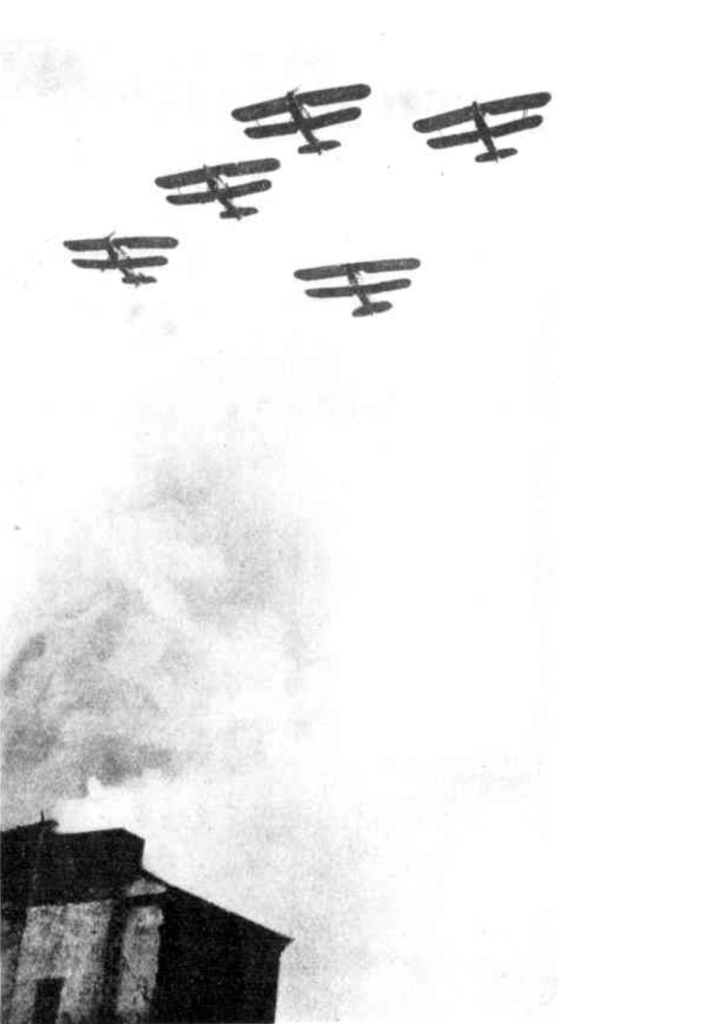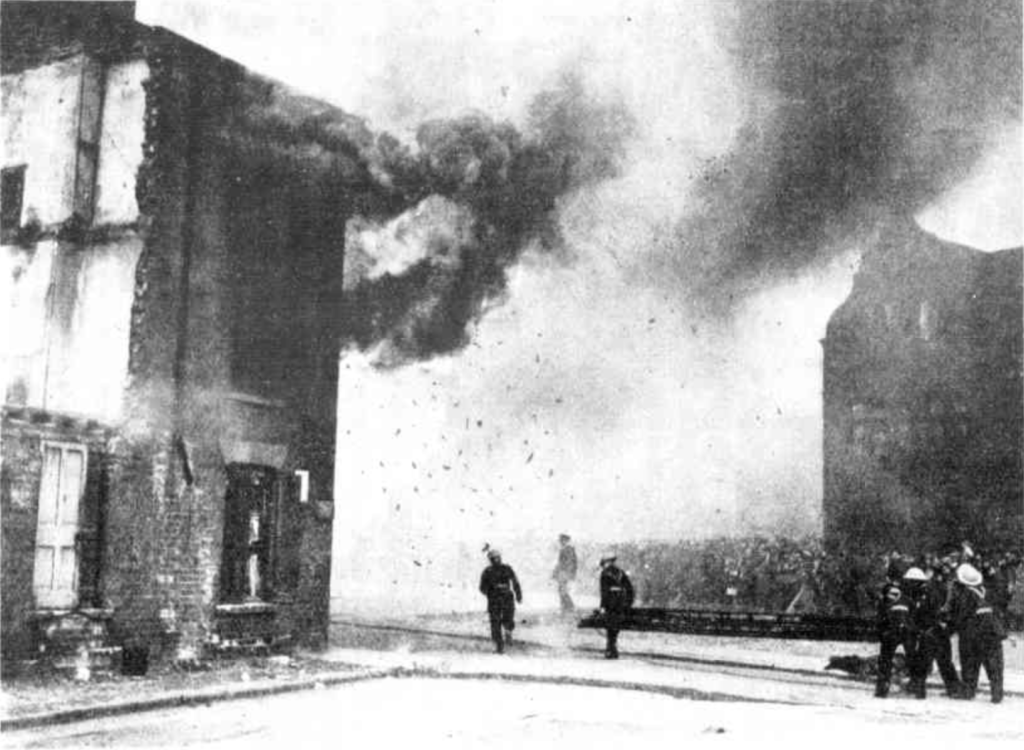
A cloud of smoke billows up from a building during a low level bombing attack carried out by biplanes. The First World War? Air control in the Middle East? Fascist bombers over Spain, or Japanese bombers over China? No, it's an air raid carried out by the RAF against Nottingham on 15 May 1938.
Of course it wasn't a real air raid: it was a mock one, something I wrote about recently in the collection edited by Michael McCluskey and Luke Seaber, Aviation in the Literature and Culture of Interwar Britain. The photos above and below were published in the British and Australian press, and I wish I'd known about them earlier because they're great illustrations of the topic and I might have been able to include them in my chapter.

So what was the story? It was both a real test of Nottingham's air raid precautions (ARP) and a very deliberate act of aerial theatre.
TEN thousand people watched to-day the first big daylight air-raid rehearsal—real aeroplanes, real fires and explosions and a fake machine-gun attack from the air—in Britain's most air-raid-minded town.1
To-day's daylight air raid was the most spectacular thing that the Air Raid Precautions department have ever done. Apart from being complete test of all the services, it was the biggest publicity stunt that has been attempted. To-morrow, Nottingham expects to enrol at least 2,000 more air raid wardens. The raid started with an attack by low-flying bombers, less than 200 feet above the heads of the crowd, and the simultaneous explosion of three 'bombs' in an old house in the Leen Side district.2

Why, at least according to the Herald, was Nottingham the 'most air-raid-minded town' in Britain? Because it had 'the biggest underground protection system in the world':
Ail the civil population of Nottingham can be accommodated in underground caves and tunnels which have been in existence for centuries. Plans for ventilating and gasprooflng the labyrinth of tunnels are now being completed by technicians.3
But Nottingham also had one of the best-organised and best-resourced ARP services in Britain. So it was an ideal showcase for the rest of the country.

The Herald seems to have been much taken with the Nottingham ARP display: it called 'London's first big air-raid protection show', at Kensington, 'astonishingly inept' by comparison.4 What it didn't mention was that the Nottingham mock air raid was not only laid on for the locals and the press photographers, but for film crews as well:
Nottingham has been selected for the making of the British National 'Air Raids Precautions' film, owing to its air raids precautions organisation being so well advanced. The film will be made in two parts, the first consisting of the episode demonstrating different forms of ARP training, and the second showing how this would be applied under war conditions. The televising of the air raid sequence in which RAF bombing 'planes take part is under consideration. British National are working in co-operation with Chief Constable Capt. A. Popkess, who is Chief Co-ordinating Officer for the ARP. Shooting starts on May 15.5
The 'televising' doesn't seem to have come off (perhaps because Alexandra Palace didn't broadcast on a Sunday, when the mock raid took place -- much to the annoyance of Sabbatarians) but the film was produced, under the title The Warning. I've long wanted to see this (back in 2008 I wrote that it had 'long piqued my interest'!), and, of course, it's now online, so I can, and I have:
Alhough a feature-length version was apparently considered at one point this version comes out at 32 minutes, which is close to the original plan of 25 minutes.6 While it's no Threads, or even a Things to Come, as a cinematic vision of the next war in the air The Warning is well worth a watch: 'Every town is a target -- any town is a target'. Air raid sirens are always going to evoke a response in me, but almost as eerie were the gas warning rattles which feature even more prominently. Civilian casualties are shown (though death is never mentioned), and at one point there's a reference to panic. The constant depictions of yet another wave of enemy bombers approaching might have been thought to induce something like panic in the audience, too. But by the time it's all over Nottingham, while bruised and battered, is not bowed. The message is that this is serious, and it will be awful, but we can prepare for it, and we must. (Sir John Anderson says as much to camera at the end, in case you've missed the point.)
But I couldn't actually spot the mock raid scenes shown above. There's certainly plenty of Nottingham (or at least what I assume is Nottingham) on show, with cleanup 'gangs' and gas decontamination squads being rushed from place to place. (Part of the point is that the ARP services are as much a line of defence as the armed forces.) And plenty of aerial footage, with Battles simulating the attackers (and Harts, maybe, over Nottingham on the day), and Spitfires, Hurricanes and Gladiators (I think) as defenders. On the ground the Territorials' anti-aircraft guns are well-represented, as well as (more oddly) the Royal Navy's. There's also a lot of footage of burning buildings and so on, most of which is probably perfectly ordinary fires, but some of it is from actual air raids in Spain.7 (One shot of three Heinkel 111s flying low over a town literally made me gasp.)
The Warning seems to have started showing in cinemas in April 1939, and did make some impression. In Aberdeen, for example, it played at Kingsway, the Majestic and the Astoria, presumably as a short in a normal programme.8 There were plans in Hastings to have searchlights play from the roof of the cinema to 'pick out RAF aeroplanes flying over the town', giving 'a first-hand idea of the psychological effect of an air raid'.9 Other towns were inspired to make their own films: the Reading Borough ARP Committee was said to be working on one 'showing Reading being bombed by enemy planes, and the work carried out by the ARP volunteers'.10 Bristol's version, called Bombs over Bristol, seems to have been edited down from the 'official ARP film' into 5 minutes and 'applied to Bristol'.11
Not everyone appreciated The Warning. Great Yarmouth's town councillors complained that 'Midland people are being "frightened" from going to the East Coast for their holidays by the Home Office ARP film "The Warning"', thanks to 'a reference in the film to Great Yarmouth being bombed':
We spend £4,000 on publicity. Are we going to sit down while this is being pushed around the country by the Home Office, spoiling our season?12
Well might one ask!
Image sources: Sydney Mail, 8 June 1938, 9; Sphere (London), 21 May 1938, 12; Daily Mirror, 16 May 1938, 17.
![]() This work is licensed under a Creative Commons Attribution-NonCommercial-NoDerivatives 4.0 International License.
Permissions beyond the scope of this license may be available at http://airminded.org/copyright/.
This work is licensed under a Creative Commons Attribution-NonCommercial-NoDerivatives 4.0 International License.
Permissions beyond the scope of this license may be available at http://airminded.org/copyright/.
- Daily Herald (London), 16 May 1938, 1. Another report put the crowd size at 15,000: Yorkshire Post (Leeds), 16 May 1938, 10. [↩]
- Daily Herald (London), 16 May 1938, 9. [↩]
- Ibid., 1. [↩]
- Ibid., 27 May 1938, 11. [↩]
- Kinematograph Weekly (London), 5 May 1938, 32. [↩]
- Nottingham Journal, 29 June 1938, 4. There was also apparently a 40-minute version: Nottingham Journal, 30 April 1940, 6. [↩]
- Western Daily Press and Bristol Mirror, 10 March 1939, 5. [↩]
- Evening Express (Aberdeen), 10 April 1939, 5. [↩]
- Hastings and St Leonards Observer, 29 April 1939, 13. [↩]
- Reading Mercury, 22 April 1939, 4. [↩]
- Western Daily Press and Bristol Mirror, 10 March 1939, 5. [↩]
- Yorkshire Observer (Bradford), 3 May 1939, 7. [↩]




